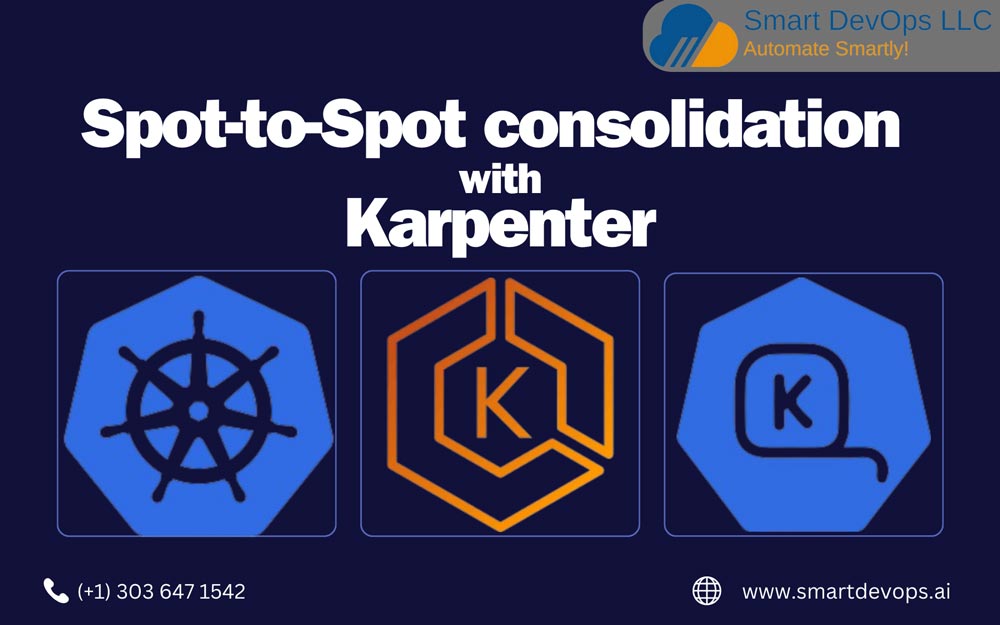
Introduction
Karpenter is an open-source tool developed by AWS for managing Kubernetes clusters and seamless integration with Kubernetes, support for Amazon EC2 Spot Instances to reduce costs, dynamic resource allocation, and scalability. Spot-to-Spot consolidation with Karpenter optimizes Kubernetes clusters by intelligently managing Amazon EC2 Spot Instances. This feature enables seamless integration of Spot Instances into Kubernetes environments, ensuring high availability and cost efficiency through dynamic node provisioning and lifecycle management.
What's New
Spot-to-Spot consolidation was introduced in Karpenter to address specific challenges and opportunities associated with Amazon EC2 Spot Instances within Kubernetes clusters. This new capability represents an evolution of Karpenter's optimization strategies for cost-effective and efficient node provisioning. It provides organizations with the ability to optimize costs, improve resource utilization, ensure fault tolerance, simplify management, and enhance scalability within Kubernetes deployments on AWS. This feature reflects Karpenter's commitment to enabling efficient and resilient cloud-native architectures.
Capabilities of Karpenter with Spot-to-Spot Consolidation ⚡
1️⃣ Spot Instance Support
Karpenter natively supports Amazon EC2 Spot Instances, which are spare capacity instances available at significantly reduced costs compared to On-Demand instances. This support enables users to leverage Spot Instances for stateless and fault-tolerant workloads, optimizing cost without compromising workload resilience.
2️⃣ Spot Interruption Handling
Karpenter automatically responds to Spot Instance interruptions by initiating the provisioning of replacement nodes. This ensures continuous availability of applications and workloads even when Spot Instances are interrupted and reclaimed by Amazon EC2.
3️⃣ Dynamic Node Provisioning
Karpenter provisions nodes dynamically in response to unschedulable pods based on resource requirements such as aggregated CPU, memory, and volume requests. It automatically scales the cluster by adding or removing nodes to accommodate workload changes.
4️⃣ Instance Lifecycle Management
Karpenter simplifies instance lifecycle management by providing features like a termination controller and instance expiration. These functionalities help ensure efficient resource utilization and prevent unnecessary costs associated with idle or unused nodes.
5️⃣ Optimized Instance Selection
Karpenter optimizes Kubernetes cluster performance by selecting the most suitable instances based on workload characteristics and constraints. It respects Kubernetes pod-to-node placement nuances such as nodeSelector (assigning pods to specific nodes), affinity/anti-affinity rules (controlling pod placement), taints/tolerations (restricting or allowing pod scheduling on nodes), and topology spread constraints (ensuring even distribution of pods across failure domains).
6️⃣ Cluster Cost Optimization
By leveraging Spot Instances and optimizing node placement, Karpenter helps users minimize infrastructure costs while maintaining high availability and scalability for Kubernetes workloads. It implements best practices for cost-effective resource allocation within the cluster.
Spot Best practices with Karpenter
1️⃣ Avoid Overly Constrained Instance Type Selection
Karpenter uses a price-capacity-optimized allocation strategy for Spot Instance selection. Avoid overly constraining instance type selection to maximize Spot capacity acquisition and reduce interruptions. A minimum of 15 instance types is recommended for better scalability and cost optimization.
2️⃣ Gracefully Handle Spot Interruptions and Consolidation Actions
Karpenter handles Spot interruption notifications by consuming events from Amazon SQS via Amazon EventBridge. Upon receiving a Spot interruption notification, Karpenter gracefully drains affected nodes and provisions replacements within 2 minutes. Test Spot interruption scenarios using AWS Fault Injection Service (FIS) for node replacement validation.
3️⃣ Carefully Configure Resource Requests and Limits for Workloads
Rightsizing pod resource requests and limits is crucial to optimize cluster performance and prevent resource contention.Set requests equal to limits for critical resources like memory to avoid potential out-of-memory (OOM) errors, especially with proactive resource reduction through Karpenter consolidation.Use tools like Kubecost or Vertical Pod Autoscaler to optimize pod resource settings and avoid resource-related issues.
4️⃣ Configure Metrics for Monitoring Karpenter
Enable monitoring of Karpenter's impact using Prometheus metrics .Utilize Amazon Managed Service for Prometheus to track interruptions, consolidation events, and other EC2 maintenance-related metrics. Monitor NodePool usage and pod lifecycles through Grafana dashboards, following the Karpenter Getting Started Guide for configuration.
Conclusion
Karpenter's Spot-to-Spot consolidation feature enhances Kubernetes cluster management on AWS by seamlessly integrating Amazon EC2 Spot Instances. It optimizes cost efficiency, fault tolerance, scalability, and resource utilization through dynamic provisioning and lifecycle management. By leveraging Spot Instances intelligently and adhering to best practices, Karpenter enables organizations to achieve resilient and cost-effective cloud-native architectures within their Kubernetes environments.
